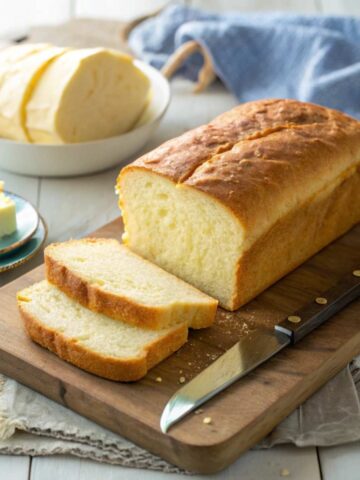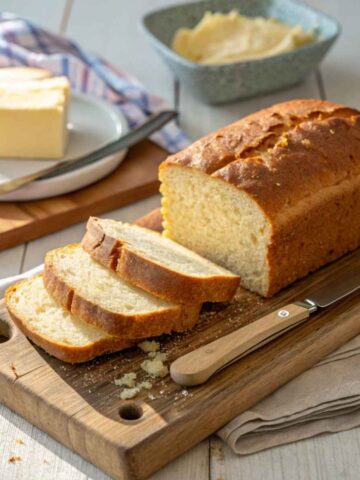Sourdough baking has been popular for centuries, and for good reason—it produces a unique, tangy flavor and a wonderfully chewy texture. But what if you're gluten-free? The good news is that you can still enjoy sourdough by making a gluten-free starter.

This guide will teach you everything you need about creating and maintaining a gluten-free starter from scratch to bake delicious, gluten-free sourdough bread at home.
Jump to:
- Understanding Sourdough and Gluten
- Benefits of Making Your Own Gluten-Free Sourdough Starter
- Key Ingredients for a Gluten-Free Sourdough Starter
- Equipment Needed to Make a Gluten-Free Sourdough Starter
- Step-by-Step Guide to Making a Gluten-Free Sourdough Starter
- How to Know When Your Gluten-Free Sourdough Starter is Ready
- Common Mistakes When Making Gluten-Free Sourdough Starters
- How to Store and Maintain Your Gluten-Free Sourdough Starter
- Reviving an Inactive or Dormant Gluten-Free Sourdough Starter
- How to Use Your GF Sourdough Starter in Baking
- Gluten-Free Sourdough Starter for Different Types of Gluten-Free Bread
- Troubleshooting Your Gluten-Free Sourdough Starter
- Frequently Asked Questions About Gluten-Free Sourdough
- Conclusion
- FAQs
- Gluten-Free Sourdough Starter
Understanding Sourdough and Gluten
How Sourdough Fermentation Works
Sourdough fermentation is a natural process where wild yeast and beneficial bacteria (lactobacilli) feed on the sugars in flour and water, producing carbon dioxide and lactic acid. This gives sourdough its characteristic tang and airy structure. While traditional sourdough is made with wheat flour, we’ll show you how to achieve similar results using gluten-free flour.
Why Traditional Sourdough is Not Gluten-Free
Traditional sourdough made from wheat flour contains gluten, giving dough elasticity and structure. Unfortunately, this means regular sourdough bread is not safe for those with celiac disease or gluten sensitivity. Thankfully, using gf flour allows you to create a starter entirely free from gluten, making sourdough accessible.
Benefits of Making Your Own Gluten-Free Sourdough Starter
Control Over Ingredients and Fermentation Process
When you make your gluten free sourdough starter, you have complete control over the ingredients. This is especially important for those with food sensitivities, as it allows you to ensure that no hidden gluten or other allergens make their way into your bread.
Health Benefits of Gluten-Free Sourdough Bread
Gluten-free sourdough bread can be easier to digest than other gluten-free bread because the fermentation process helps break down some of the complex carbohydrates and proteins in the flour. This can lead to better gut health and improved nutrient absorption.
Key Ingredients for a Gluten-Free Sourdough Starter
The Best Gluten-Free Flours for Sourdough Starters
Choosing the suitable flour is essential for creating a successful gf sourdough starter. Some of the best options include:
- Brown rice flour: A common choice for gluten-free starters, providing a mild flavor and reliable fermentation.
- Sorghum flour: Offers a neutral flavor and works well for feeding your starter.
- Buckwheat flour: Adds a unique, nutty flavor and helps create an active starter.
Water: The Right Type for Fermentation
When making sourdough, your water is just as crucial as the flour. Filtered or bottled water is ideal because tap water can contain chlorine or other chemicals that may hinder the fermentation process.
Equipment Needed to Make a Gluten-Free Sourdough Starter
To make a gluten free sourdough starter, you’ll need a few simple tools:
- Glass or plastic jar: Avoid using metal containers, which can react with the starter.
- Kitchen scale: Measuring ingredients by weight ensures consistency.
- Spoon or spatula: For mixing the flour and water.
- Cloth or loose-fitting lid: To cover the jar and allow airflow while preventing contaminants.
Step-by-Step Guide to Making a Gluten-Free Sourdough Starter
Day 1: Mixing Flour and Water
Combine 1/2 cup of gluten-free flour with 1/2 cup of water in a jar on the first day. Stir until smooth, cover loosely with a cloth, and leave at room temperature.
Day 2-7: Feeding Your Starter and Watching It Grow
Each day, discard half of the starter and feed it with another 1/2 cup of flour and 1/2 cup of water. By the end of the week, your starter should be bubbly and active, with a pleasant tangy smell.
How to Know When Your Gluten-Free Sourdough Starter is Ready
Signs of a Healthy, Active Starter
A healthy gf sourdough starter will show visible bubbles, rise and fall predictably, and have a slightly sour, but not unpleasant, aroma.
What to Do if Your Starter Isn’t Rising Properly
If your starter isn’t rising, it may need more warmth or a different type of flour. Try placing it in a warmer spot (around 70°F to 75°F) or switching to flour like brown rice, which ferments quickly.
Common Mistakes When Making Gluten-Free Sourdough Starters
Overfeeding or Underfeeding the Starter
Overfeeding your starter can dilute its natural yeast and bacteria, while underfeeding can starve it. Stick to regular feedings once every 24 hours to keep it active.
Problems with Water Quality or Temperature
Using chlorinated water or keeping your starter in a cold environment can slow down fermentation. Be sure to use filtered water and keep your starter in a warm, draft-free spot.
How to Store and Maintain Your Gluten-Free Sourdough Starter
Storing in the Fridge vs. Keeping at Room Temperature
If you bake regularly, you can keep your starter at room temperature and feed it daily. If you bake less often, store it in the fridge and feed it once a week.
How Often to Feed Your Starter
A gf sourdough starter must be fed once every 24 hours at room temperature. You can feed it in the fridge once a week.
Reviving an Inactive or Dormant Gluten-Free Sourdough Starter
What to Do If Your Starter Stops Bubbling
If your starter becomes inactive, discard half and feed it with fresh flour and water. Keeping it in a warm spot can help kickstart fermentation again.
Tips for Bringing a Dormant Starter Back to Life
Increase feedings to twice a day. Try using a different gluten-free flour to add variety and nutrients to the starter.
How to Use Your GF Sourdough Starter in Baking
Gluten-Free Sourdough Bread Recipes
Once your starter is active, you can bake delicious gluten-free sourdough bread. The recipe typically combines the starter with gluten-free flour, water, salt, and sometimes oil or honey for flavor. Allow the dough to rise for several hours before baking to achieve a chewy, flavorful loaf.
Basic Gluten-Free Sourdough Bread Recipe:
- 1 cup active gf sourdough starter
- 2 cups gluten-free flour (a blend like rice, sorghum, or buckwheat)
- 1 cup water
- One teaspoon salt
Combine the ingredients, let the dough rise for 4-6 hours, then bake at 375°F (190°C) for 40-50 minutes.
Using the Starter in Pancakes, Waffles, and More
Your gf sourdough starter isn’t just for bread! You can make gluten-free sourdough pancakes, waffles, or even pizza crusts. Fermentation gives these foods a unique tang and light, fluffy texture. Substitute a portion of the flour in your favorite recipes with your starter.
Gluten-Free Sourdough Starter for Different Types of Gluten-Free Bread
Whole Grain Gluten-Free Sourdough
Use whole grain gf flour like buckwheat, teff, or millet in your sourdough starter for a more robust flavor. These flours add depth of flavor and a denser texture to your bread, making it an excellent choice for sandwiches or toast.
Light and Fluffy Gluten-Free White Bread
If you prefer lighter bread, use flour like white rice flour or a gluten-free all-purpose blend. This will result in a softer, fluffier loaf, perfect for sandwiches or breakfast toasts.
Troubleshooting Your Gluten-Free Sourdough Starter
Why Your Starter Smells Off
If your starter smells overly sour or has a foul odor, it may be due to over-fermentation or contamination. Discard any liquid that forms on top, feed it with fresh flour and water, and move it to a more fantastic location.
What to Do if Mold Appears
If you see mold growing on your starter, it’s best to discard it and start fresh. Mold indicates contamination, which can make the starter unsafe to use.
Frequently Asked Questions About Gluten-Free Sourdough
Can You Convert a Regular Sourdough Starter to Gluten-Free?
While converting a regular sourdough starter by gradually incorporating gf flour is possible, starting a new gf starter from scratch is more accessible and safer. This avoids contamination with gluten.
How Long Does it Take to Make a Gluten-Free Sourdough Starter?
A gluten-free sourdough starter usually takes 5-7 days to become fully active and ready for baking. Consistent feeding and a warm environment will help it develop more quickly.
Conclusion
Creating your gluten free sourdough starter is rewarding, allowing you to enjoy fresh, homemade, gluten-free bread and baked goods. By following this guide, you’ll have complete control over the ingredients. You can experiment with different gluten-free flours to find your favorite flavor combinations.
With patience and attention, you’ll have a bubbling, active starter ready to bake, bringing sourdough's tangy, chewy texture into your gluten-free kitchen.
FAQs
Yes, you can use a variety of gluten-free flours, including brown rice, sorghum, buckwheat, and more. Some flours ferment more quickly than others, so experiment to find the best option for your starter.
With proper feeding and maintenance, your gluten-free starter can last indefinitely. It can be kept at room temperature with daily feedings or in the fridge with weekly feedings.
Many people find that gluten-free sourdough is easier to digest due to the fermentation process, which breaks down some of the flour's complex carbohydrates.
If you skip a feeding, your starter may become inactive or develop a layer of liquid on top. Simply discard half of the starter, feed it, and give it time to become active again.
You can store your gluten-free sourdough starter in the fridge for several weeks without feeding it. When you’re ready to bake again, take it out, feed it, and let it become active before using.

Gluten-Free Sourdough Starter
- Total Time: 10 minutes
- Yield: 1 starter 1x
Description
This easy gluten-free sourdough starter is the perfect base for making tangy,delicious sourdough bread and baked goods. With just gluten-free flour andwater, you can create an active, bubbly starter for all your gluten-free sourdough recipes.
Ingredients
- 1/2 cup gluten-free flour (such as brown rice, sorghum, or buckwheat)
- 1/2 cup filtered water
Instructions
- Day 1: Mix 1/2 cup gluten-free flour with 1/2 cup water in a clean glass jar. Stir well, cover loosely with a cloth, and let sit at room temperature for 24 hours.
- Day 2-7: Discard half the starter daily and feed with 1/2 cup flour and 1/2 cup water. Stir well and allow it to ferment at room temperature.
- By Day 7, your starter should be bubbly and ready to use in gluten-free sourdough bread recipes.
Notes
Once your starter is active, store it in the fridge between uses and feed it once a week to keep it alive. When you’re ready to bake, remove the starter from the fridge, feed it, and allow it to become active before using.
- Prep Time: 10 minutes
- Category: Baking Ingredient
- Cuisine: gluten-free
Nutrition
- Calories: 4
Keywords: gluten-free baking, Gluten-Free Sourdough, sourdough starter





Leave a Reply